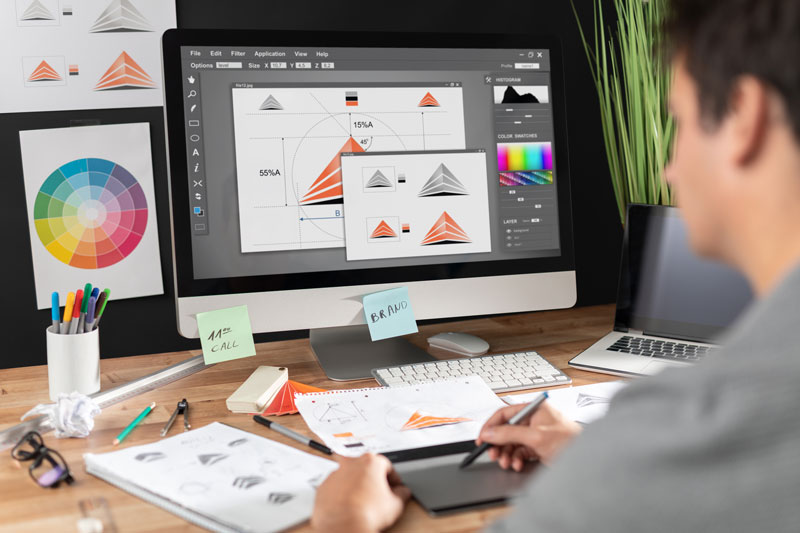Printing technology has come a long way in recent years, with numerous advancements being made in various areas of the industry. From 3D printing to digital inkjet printing, there have been significant improvements in the quality and cost-effectiveness of printers and inks, as well as the software used to render and control them. These innovations have made printing more accessible and efficient than ever before, and have opened up new possibilities for businesses and individuals alike.
One area where there have been particularly exciting developments is in the field of 3D printing. The latest printers are capable of using multiple materials in a single object, and are up to 10 times faster than previous models. This has made it possible to produce complex, multi-material designs quickly and efficiently, and has opened up new opportunities in industries such as healthcare, aerospace, and automotive manufacturing. Additionally, emerging technologies such as erasable printing and security printing are making it possible to create more secure and environmentally friendly printed materials.
As the printing industry continues to evolve, it is clear that there will be many more exciting developments to come. From cost-effective printers to automation and cloud printing, there are many new technologies and services that are making printing more accessible and efficient than ever before. Whether you are a business owner looking to improve your printing workflow, or an individual looking to create personalized printed materials, there has never been a better time to explore the latest advancements in printing technology.
3D Printing Innovations
The field of 3D printing has been rapidly evolving in recent years, with new technologies and techniques emerging that are pushing the boundaries of what is possible. Two of the most exciting developments in this area are multiple material printing and resin-based printing.
Multiple Material Printing
One of the biggest limitations of traditional 3D printing is that it is typically only able to work with a single material at a time. However, recent advances have made it possible to print objects using multiple materials, allowing for much more complex and intricate designs.
This has been made possible through the development of new printing technologies that are able to switch between different materials on the fly. For example, some printers are able to use a combination of plastic and metal to create objects with a wide range of properties, from flexibility to strength.
Resin-Based Printing
Another exciting development in the world of 3D printing is the rise of resin-based printing. Unlike traditional 3D printing, which uses a layer-by-layer approach to build up objects, resin-based printing uses a liquid resin that is cured using ultraviolet light.
This approach allows for much greater precision and detail, as well as the ability to print objects with much smoother surfaces. Resin-based printing is also able to produce objects with a wider range of properties, from flexible to rigid.
Overall, the latest advancements in 3D printing are opening up a whole new world of possibilities for designers, engineers, and manufacturers. Whether you are looking to create complex multi-material objects or highly detailed resin-based prints, there is a 3D printing solution out there that can help you achieve your goals.
Advancements in Digital and Inkjet Printing
With the rapid development of technology, printing has also evolved and improved significantly. Digital and inkjet printing are two of the most popular printing methods that have seen significant advancements in recent years.
Production Inkjet Technology
Production inkjet technology is a type of digital printing that has gained popularity due to its speed, quality, and cost-effectiveness. It is widely used in commercial printing, packaging, and labeling industries. This technology allows for high-speed printing of large volumes of documents, labels, and packaging materials. Production inkjet technology has advanced to the point where it can print on a wide range of substrates, including plastics, metal foils, and textiles.
The latest production inkjet printers use high-quality inks that are resistant to water, fading, and smudging. They also have improved color accuracy and consistency, making them suitable for printing high-quality images and graphics.
Digital Inkjet Printing
Digital inkjet printing is another printing technology that has seen significant advancements in recent years. It is a non-contact printing process that uses inkjet nozzles to deposit ink onto a substrate. Digital inkjet printing is widely used in the textile, signage, and packaging industries.
The latest digital inkjet printers use advanced software and hardware to achieve high-quality prints with accurate color reproduction. They can print on a wide range of substrates, including paper, plastic, and metal. Digital inkjet printing also allows for variable data printing, which enables the printing of personalized documents, labels, and packaging materials.
In conclusion, the advancements in digital and inkjet printing technology have revolutionized the printing industry. The latest production inkjet and digital inkjet printers have improved speed, quality, and cost-effectiveness, making them suitable for a wide range of applications.
Software Innovations in Printing
Printing technology has come a long way from traditional printing methods to digital printing, and now, with the help of software innovations, the industry is moving towards more efficient and streamlined processes. In this section, we will explore the latest software innovations in printing, including automation, workflow, and security.
Automation and Workflow
Automation and workflow software have become essential tools for printing companies to improve their productivity and efficiency. These software solutions help automate repetitive tasks, such as prepress file preparation, color management, and job scheduling. By automating these tasks, printing companies can reduce costs, improve turnaround times, and increase accuracy.
One example of automation software is Print MIS, which is a management information system designed specifically for the printing industry. Print MIS software helps printing companies manage their entire workflow, from job estimation to invoicing. It automates tasks such as job scheduling, inventory management, and purchasing, reducing the need for manual intervention.
Security in Printing Software
Security is a critical concern in the printing industry, especially when it comes to printing sensitive documents such as financial statements, legal documents, and government documents. Printing software solutions now include security features such as password-protected files, encrypted data transmission, and secure printing.
One example of secure printing software is FollowMe, which is a print management solution that provides secure printing capabilities. FollowMe allows users to send print jobs from any device, including smartphones and tablets, and release them at any printer on the network. The software also includes features such as user authentication, audit trails, and data encryption to ensure the security of printed documents.
In conclusion, software innovations have played a crucial role in advancing the printing industry. Automation and workflow software have helped printing companies improve their productivity and efficiency, while security features have helped protect sensitive documents from unauthorized access. As technology continues to evolve, we can expect to see even more software innovations in the printing industry.
Improvements in Printing Equipment and Materials
Advances in Printers
Printing technology has come a long way over the years with many advancements in printers. One of the most significant improvements is the development of inkjet printers. Inkjet printers have become more efficient, reliable, and cost-effective. They are now capable of printing high-quality images at a faster speed and with more accuracy than ever before.
Another significant advancement in printers is the development of 3D printers. 3D printing is a rapidly evolving technology that is changing the way we think about manufacturing. These printers can create complex shapes and designs that were previously impossible with traditional printing methods.
New Inks and Substrates
Ink technology has also seen significant improvements. New inks have been developed that are more durable, vibrant, and resistant to fading. Some of the latest inks include UV-curable inks, which are cured by exposure to ultraviolet light. These inks are more durable and resistant to fading than traditional inks.
Substrates, or the materials onto which prints are made, have also seen significant improvements. New materials such as vinyl, polyester, and polypropylene have been developed that are more durable, weather-resistant, and long-lasting than traditional printing materials. These materials are ideal for outdoor signage, banners, and other applications where durability is essential.
In addition to new substrates, advancements have been made in the coatings used to protect prints. New coatings are more scratch-resistant, UV-resistant, and offer better protection against fading.
Overall, the advancements in printing equipment and materials have made printing more efficient, cost-effective, and environmentally friendly. As the technology continues to evolve, we can expect even more improvements in the future.
Cost Effectiveness and Efficiency
Printing technology has come a long way in recent years, with new advancements that are making printing more cost-effective and efficient. This section will explore some of the latest technologies that are helping to reduce costs and increase productivity.
Cost-Effective Printers
One of the most significant advancements in printing technology has been the development of cost-effective printers. These printers are designed to be more energy-efficient, use less ink or toner, and require fewer maintenance costs than traditional printers. They are also much faster than older models, which means that businesses can produce more output in less time.
Another way that printers are becoming more cost-effective is through the use of refillable ink tanks. These tanks can hold a much larger volume of ink than traditional cartridges, which means that they need to be replaced less often. This can result in significant cost savings over time, especially for businesses that do a lot of printing.
Erasable Printing Technology
Another exciting development in printing technology is the use of erasable printing. This technology allows users to print documents that can be erased and reused multiple times, reducing the need for paper and ink. This is particularly useful for businesses that need to print a lot of temporary documents, such as memos and schedules.
Erasable printing technology works by using a special type of ink that can be erased with heat. This ink is printed onto a special type of paper that can withstand the heat required to erase the ink. Once the ink is erased, the paper can be reused, reducing the need for new paper and ink.
Overall, these advancements in printing technology are making it more cost-effective and efficient for businesses to produce high-quality printed materials. By using cost-effective printers and erasable printing technology, businesses can save money on ink, toner, and paper, while also reducing their environmental impact.
Security and Control in Printing
Printing technology has advanced significantly over the years, and with that comes the need for enhanced security and control measures. In this section, we will explore the latest advancements in security and control in printing.
Security Printing
Security printing involves the use of special techniques and materials to prevent counterfeiting and forgery. Some of the latest security printing techniques include:
- Special security paper: Manufacturers add security elements and features, like watermarks, security threads, and fluorescent fibers, to the paper’s structure, making it difficult to duplicate.
- Holograms: Holograms are used to create a 3D image that is difficult to replicate.
- Microtext: Microtext is tiny text that is difficult to read without magnification, making it challenging to replicate.
Control in Printing Process
Control in the printing process involves limiting access to printers and controlling what can be printed. Some of the latest control measures include:
- Group-based access control: Using groups in printing software to control access to printers and print jobs based on user roles and permissions.
- Print quotas: Setting print quotas to limit the number of pages that can be printed by an individual or group.
- Print job release: Requiring users to release print jobs at the printer, ensuring that sensitive documents are not left unattended.
In conclusion, the latest advancements in printing technology have brought about enhanced security and control measures to prevent counterfeiting, forgery, and unauthorized access. With the use of security printing techniques and control measures in the printing process, individuals and organizations can ensure that their sensitive documents are protected.
Global Trends in Printing Technology
The printing industry has undergone significant transformation in recent years, thanks to advancements in technology. As a result, the industry has witnessed a shift from traditional printing methods to digital printing. This shift has been driven by the need for faster turnaround times, cost-effectiveness, and the ability to print on demand. In this section, we will explore the global trends in printing technology, with a focus on Asia, online, and cloud printing.
Printing Industry in Asia
Asia is emerging as a key player in the printing industry, with countries like China and India leading the way. The printing industry in Asia is expected to grow significantly in the coming years, driven by increasing demand for packaging, labels, and commercial printing. The rise of e-commerce and the need for on-demand printing are also driving growth in the industry.
Online Printing
Online printing has become increasingly popular in recent years, thanks to the convenience it offers. Customers can now order prints from the comfort of their homes or offices, and have them delivered right to their doorstep. Online printing has also made it easier for businesses to manage their printing needs, with features like online design tools, templates, and print management systems.
Cloud Printing
Cloud printing is another trend that is gaining popularity in the printing industry. This technology allows users to print from anywhere, using any device, as long as they have an internet connection. Cloud printing eliminates the need for drivers, software, and hardware, making it a cost-effective and convenient option for businesses.
In conclusion, the printing industry is evolving rapidly, with new technologies and trends emerging every day. As the industry continues to grow, it is important for businesses to stay up-to-date with the latest advancements in printing technology, to remain competitive and meet the changing needs of their customers.
Future of Printing Technology
The printing industry is constantly evolving, and the future looks bright with advancements in technology. In this section, we will discuss the future of printing technology, including emerging technologies, personalization, and collaboration.
Emerging Technologies
Emerging technologies are changing the printing industry. One of the most significant changes is the shift towards digital printing. Digital printing allows for faster turnaround times, lower costs, and greater flexibility. Additionally, 3D printing is becoming more accessible, allowing for the creation of complex and customized objects.
Another emerging technology is augmented reality (AR). AR technology allows for the creation of interactive print materials that can be viewed through a mobile device. This technology can enhance the user experience and provide additional information or entertainment.
Personalization
Personalization is becoming increasingly important in the printing industry. Consumers are looking for unique and customized products that reflect their individuality. Printing technology has evolved to meet this demand, with the ability to print personalized products such as photo books, invitations, and business cards.
Variable data printing (VDP) is another technology that allows for personalization. VDP allows for the customization of individual pieces within a print run, such as personalized names or addresses on direct mail pieces.
Collaboration
Collaboration is an essential aspect of the future of printing technology. With the rise of digital printing, collaboration between designers, printers, and clients has become easier and more efficient. Online collaboration tools allow for real-time feedback, reducing the time and cost associated with traditional proofing methods.
Collaboration also extends to the supply chain. Printers are collaborating with suppliers to develop sustainable printing practices, such as the use of eco-friendly inks and papers.
In conclusion, the future of printing technology is exciting, with emerging technologies, personalization, and collaboration driving innovation in the industry. As the industry continues to evolve, printers must adapt to meet changing consumer demands and embrace new technologies to remain competitive.



